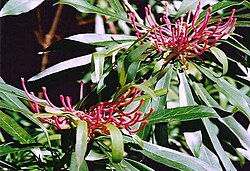Difference between revisions of "Telopea mongaensis"
| Line 4: | Line 4: | ||
|species=mongaensis | |species=mongaensis | ||
|taxo_author=Cheel | |taxo_author=Cheel | ||
| + | |habit=shrub | ||
| + | |habit_ref=Wikipedia | ||
|Max ht box=10 | |Max ht box=10 | ||
|Max ht metric=ft | |Max ht metric=ft | ||
| + | |height_ref=Flora - A Gardener's Encyclopedia | ||
|Max wd box=10 | |Max wd box=10 | ||
|Max wd metric=ft | |Max wd metric=ft | ||
| + | |width_ref=Flora - A Gardener's Encyclopedia | ||
|lifespan=perennial | |lifespan=perennial | ||
| + | |life_ref=Flora - A Gardener's Encyclopedia | ||
|exposure=sun | |exposure=sun | ||
| + | |sun_ref=Flora - A Gardener's Encyclopedia | ||
|flower_season=early spring, mid spring, late spring, early summer, mid summer, late summer | |flower_season=early spring, mid spring, late spring, early summer, mid summer, late summer | ||
| + | |flower_ref=Flora - A Gardener's Encyclopedia | ||
|flowers=red, pink | |flowers=red, pink | ||
|Temp Metric=°F | |Temp Metric=°F | ||
|min_zone=8 | |min_zone=8 | ||
| + | |usda_ref=Flora - A Gardener's Encyclopedia | ||
|max_zone=10 | |max_zone=10 | ||
| − | |||
|image=Telopea mongaensis at Monga National Park.jpg | |image=Telopea mongaensis at Monga National Park.jpg | ||
|image_width=240 | |image_width=240 | ||
Latest revision as of 19:29, 20 April 2010
| Habit | shrub
| |
|---|---|---|
| Height: | ⇕ | 10 ft"ft" can not be assigned to a declared number type with value 10. |
| Width: | ⇔ | 10 ft"ft" can not be assigned to a declared number type with value 10. |
| Lifespan: | ⌛ | perennial |
| Bloom: | ❀ | early spring, mid spring, late spring, early summer, mid summer, late summer |
| Exposure: | ☼ | sun |
|---|---|---|
| USDA Zones: | 8 to 10 | |
| Flower features: | ❀ | red, pink |
|
Telopea > |
Cheel > |
Telopea mongaensis, commonly known as the Monga Waratah or Braidwood Waratah, is a shrub or small tree in the Proteaceae family. Endemic to Australia, it grows at high altitude in south eastern New South Wales. It bears many red flowerheads in spring, each made up of 28 to 65 individual flowers, and has narrow green leaves. It is often seen in moist areas at the edge of rainforest or by streams in eucalyptus forests.
Telopea mongaensis grows as a tall shrub to 6 m (20 ft) high. The thin leaves are 4–18 cm (1.6–7 in) in length, and 0.5–2 cm (0.2–0.8 in) wide. The red flowers form in spring. Open, thin and wiry, the flowerheads (inflorescences) are not as spectacular as those of T. speciosissima but are much more numerous on the plant. Each flowerhead is around 6 to 10 cm (2.4-4 in) in diameter, and composed of anywhere from 28 to 65 individual small flowers, or florets. Anthesis, or the opening of the flowers, begins at the edges or base of the flowerhead and moves to the centre.[1] The individual flower bears a sessile anther (that is, it lacks a filament), which lies next to the stigma at the end of the style. The ovary lies at the base of the style and atop a stalk known as the gynophore, and it is from here that the seed pods then develop. Meanwhile, a crescent shaped nectary lies at the base of the gynophore.[2] The flowerheads are surrounded by green or pink leafy bracts 1.2-4.5 cm (0.5-0.9 in) in length, much less prominent than those of the New South Wales Waratah. Flowering is followed by the development of woody seed pods, 4.5–7 cm (0.9-2.8 in) long.[1]
It can be distinguished from the similar T. oreades, which has larger leaves and often grows with a tree-like habit.[3]
Cultivation
Telopea mongaensis is more tolerant of shade, heavier soils and cooler climates than its more showy relative. It grows as a more compact plant of around 2 m (7 ft) in height in full sun. It is frost tolerant and has been grown in southern England, and has been awarded an Award of Merit by the Royal Horticultural Society in 1980. It attracts birds to the garden.[3]
Propagation
Pests and diseases
Varieties
'Braidwood Brilliant' is a hybrid between this species and the showy Telopea speciosissima.[4]
Gallery
References
- ↑ 1.0 1.1 Cite error: Invalid
<ref>tag; no text was provided for refs namedFoA - ↑ Willis, JL (1959). "The genus Telopea". Australian Plants (Chipping Norton, NSW: Surrey Beatty & Sons) 1 (1): 7-10.
- ↑ 3.0 3.1 Wrigley, John; Fagg, Murray (1991). Banksias, Waratahs and Grevilleas. Sydney: Angus & Robertson. p. 539. ISBN 0-207-17277-3.
- ↑ [1]
External links
- w:Telopea mongaensis. Some of the material on this page may be from Wikipedia, under the Creative Commons license.
- Telopea mongaensis QR Code (Size 50, 100, 200, 500)

